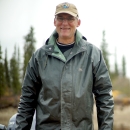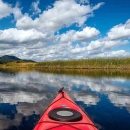Here in Northwest Alaska, our summers are often warmer and our winters less cold than in decades past. Breakups are coming earlier, and freezeups later. How do these changes influence the water temperatures in our rivers?
And what does this mean for creatures living in the rivers?
Warmer water holds less dissolved oxygen, and is less suitable for certain species of Alaskan fish, notably salmon. Bill Carter, Selawik Refuge fishery biologist, has been teaming with the US Fish & Wildlife Service’s Alaska regional water resources team to set up and maintain a network of water temperature monitoring sites in the refuge.
We currently have five water temperature monitoring sites in the Selawik watershed. Those are:
- at the Kuugruaq (Kugaraq) River (upstream from the First Forks area),
- in the lower Tagraġvik (Tagagawik) River
- in the Selawik River above Second Forks (the confluence with the Tagraġvik)
- below the sheefish spawning grounds in the middle Selawik,
- and in the upper Selawik near the upstream end of the sheefish spawning grounds, above Iñġisugruk (also called Shovel Creek).
While we don’t currently have any monitors in the Kobuk River, we have had discussions about adding a site near Noorvik.
We selected sites further upriver in the Selawik, as opposed to near the village, for a few reasons. First, water temperature is especially important near critical fish spawning areas. Water temperatures are an important factor in triggering sheefish to spawn, and water temperature also makes a difference in how long it takes for fertilized eggs to develop and hatch. Second, we’re less likely to see variations in water temperature near the village, due to the deeper water and inputs from warmer water sources (lake or tundra runoff).
At each of the water temperature monitoring sites, we have a 12-inch piece of PVC pipe with two temperature logger devices inside. This is anchored to the shore with a 30-foot cable. We chose locations that melt out early and are protected from major ice scouring, but it can still be a challenge to locate and download data from the loggers after a year in a dynamic river environment.
The loggers record the water temperature once per hour. This allows us to look at day to day trends. The loggers have no remote digital connection, so we need to physically visit the site once per year and download the information from the instrument.
This type of data is useful for long-term monitoring, year-to-year comparisons, and understanding how temperatures change throughout the season. However, it doesn’t provide real-time information that would allow us to anticipate the possibility of a fish die-off.
Warm shallow water, a high number of fish, and possible algae growth are believed to be the causes for the salmon die-off in the Kobuk River in 2016. There is concern across Alaska that warming rivers and decreasing snowpack might be harmful for salmon spawning success in coming years.
Luckily, not all fish are equally sensitive to temperature. Northern pike and the whitefish species can tolerate a wider range of water temperatures, in part because they do not congregate in large groups during the summer season.
None of the temperatures so far in Selawik Refuge indicate any signs of danger for local fish, but they do give us a picture of the current situation that we can use to compare with future years.



